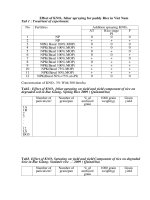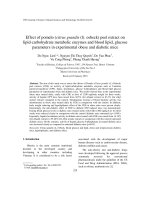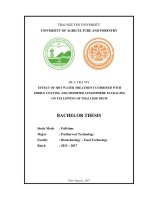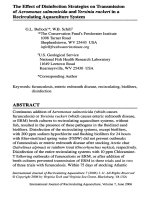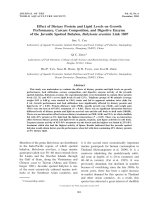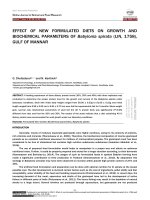Effect of spacing and periodical staggered nipping on botrytis disease incidence and quality of castor (Ricinus communis L.)
Bạn đang xem bản rút gọn của tài liệu. Xem và tải ngay bản đầy đủ của tài liệu tại đây (493 KB, 7 trang )
Int.J.Curr.Microbiol.App.Sci (2018) 7(11): 2822-2828
International Journal of Current Microbiology and Applied Sciences
ISSN: 2319-7706 Volume 7 Number 11 (2018)
Journal homepage:
Original Research Article
/>
Effect of Spacing and Periodical Staggered Nipping on Botrytis Disease
Incidence and Quality of Castor (Ricinus communis L.)
K. Sunil Kumar1* and H.S. Shivaramu2
1
2
UAS, Dharwad, Karnataka, India
Department of Agrometeorology, UAS, Bengaluru, Karnataka, India
*Corresponding author
ABSTRACT
Keywords
Castor, Spacing,
Nipping, Botrytis
Article Info
Accepted:
22 October 2018
Available Online:
10 November 2018
The field experiment was conducted during the kharif seasons of 2013 and 2015 at ZARS,
University of Agricultural Sciences, Gandhi Krishi Vigyan Kendra, Bengaluru on red
sandy clay loam soil to know the influence of periodical staggered nipping and spacing on
Botrytis disease infestation and quality of castor. Nipping and different spacing’s in castor
significantly influenced the disease incidence and castor oil yield. Periodical staggered
nipping leaving one spike in each branch recorded lower Botrytis disease scoring (2.71)
and chaffiness (6.43 %) as compared to non-nipping treatments. This treatment also
recorded significantly higher oil content (44.34 %) and oil yield (7.75 q ha -1). Among the
different spacing levels lower Botrytis disease scoring (3.17), chaffiness (11.61 %) and
significantly higher oil content (44.29 %) were noticed with the spacing of 120 x 45 cm.
Whereas, significantly higher oil yield was recorded in the spacing of 90 x 45 cm (6.91 q
ha-1). Interaction effects between periodical staggered nipping and spacing were not
significant.
Introduction
Among oilseeds, castor (Ricinus communis L.)
is the most primitive non-edible crop
belonging to family Euphorbiaceae grown
under tropical, sub-tropical and temperate
regions. Seeds of this crop were found during
excavation in Egypt, Sudan, India and in
ancient agricultural dwellings of North West
Asia and Iran. Evidences indicate that the crop
was originated in Ethiopia (Weiss, 1971) and
in India (Moshkin, 1986). Its cultivation is
spread over thirty countries of the world.
India, Mozambique, China, Brazil, Angola,
Philippines and Thailand are the leading
countries and producing nearly 85 per cent of
the total castor production of the world. As a
non-edible and industrial crop, castor plays an
important role in Indian economy because of
better export potential. During 2014-15, the
country earned a foreign exchange worth of ₹
4364.33 crores through export of castor oil
and cake (Anon, 2015).
The castor plant being perennial in nature is
capable of producing branches from every
auxillary bud that appears on its main axis.
The lower shoots that develop from the
auxillary buds many a times produce spikes
not as much effective as main spike. Nutrition
2822
Int.J.Curr.Microbiol.App.Sci (2018) 7(11): 2822-2828
to the lower branches thus gets wasted
resulting in weaker spikes of short length, high
susceptibility to diseases, particularly Bortytis,
thus resulted in chaffiness, poor seed weight
and lower yield (Patel et al., 1976). In castor,
maintenance of source to sink relationship is
very important rather than allowing more
vegetative growth presumably for higher
yields. Hence, staggered nipping i.e., removal
of auxillary buds assumes importance in
maintaining optimum source to sink
relationship. Keeping this in view, an attempt
has been made in present study to find out the
impact of staggered nipping and different
spacing on Botrytis disease incidence and
quality of castor.
emergence of primary spike. The secondary
branch emerging just below the primary spike
is allowed to grow and it ends with a spike at
the tip. Then all the nodal buds of the
secondary branch will be nipped-off except
the one below the secondary spike. All the
nodes of tertiary branch will be nipped-off
except the one below the tertiary spike. In the
same way one quaternary, penta and hexa
branches and spikes will be allowed
respectively. It is done in the experiment
according to the different nipping treatments
(Fig. 1). After periodical harvesting the spikes,
capsules were dried and threshed. Seed yield
and stalk yield in each plot was recorded and
analysed statistically.
Materials and Methods
Botrytis disease scoring
The field experiment was conducted during
the kharif seasons of 2013 and 2015 at ZARS,
University of Agricultural Sciences, Gandhi
Krishi Vigyan Kendra, Bengaluru on red
sandy clay loam soil. The soils were medium
in available nitrogen (295.5 kg ha-1), available
phosphorus (34.20 kg ha-1) and available
potassium (155.75 kg ha-1). The organic
carbon (0.51 %) content was also medium.
The experiment was laid out in Randamized
Complete Block Design consisting of three
levels of spacing (60 × 45 cm, 90 × 45 cm and
120 × 45 cm) and nipping (no nipping,
periodical staggered nipping leaving one spike
in each branch and periodical staggered
nipping leaving two spikes in each branch)
and replicated thrice. The recommended dose
of 38:38:25 kg NPK and 5t of FYM ha-1 was
given to castor. Intercultivation and weeding
were done to keep the weeds under check.
Need based plant protection was followed to
control sucking insects. Staggered nipping in
case of castor is a selective removal of nodal
buds at regular intervals. The methodology
includes nipping of all the nodal buds in the
primary stem except the one just below the
primary spike immediately after the
Gray mould (Botrytis ricini) is a major disease
in castor infecting flowers and capsules. The
extent of damage goes even up to 85 per cent
depending
on
the
humidity.
Night
o
temperatures below 22 C followed by rains
are highly favourable for the spread of disease
(Diraviam, 2006). The severity of Botrytis
disease was assessed by adopting 1-9 scale
(Subramanyam et al., 1982) as given below.
Scale: Per cent of infestation
0:
1:
3:
5:
7:
9:
No incidence
1 per cent of capsule infected
2-10 per cent of capsule infected
11-25 per cent of capsule infected
26-50 per cent of capsule infected
>50 per cent of capsule infected
Results and Discussion
Effect of spacing
Spacing has significant influence on Botrytis
diseases and chaffiness of castor. The
incidence of disease was observed maximum
in the lower spacing.
2823
Int.J.Curr.Microbiol.App.Sci (2018) 7(11): 2822-2828
2824
Int.J.Curr.Microbiol.App.Sci (2018) 7(11): 2822-2828
Table.1 Botrytis disease scoring (0-9 Scale) study in castor at different pickings as influenced by spacing and nipping
1st picking
Treatment
2nd picking
3rd picking
Overall mean
2013
2015
Pooled
2013
2015
Pooled
2013
2015
Pooled
2013
2015
Pooled
S1: 60 x 45 cm
3.74
5.09
4.42
4.08
5.42
4.75
4.32
5.51
4.92
4.05
5.34
4.69
S2: 90 x 45 cm
2.73
4.31
3.52
3.33
4.96
4.14
3.41
5.01
4.21
3.16
4.76
3.96
S3: 120 x 45 cm
2.24
3.23
2.74
2.84
3.78
3.31
3.03
3.89
3.46
2.71
3.63
3.17
N0
4.07
5.79
4.93
4.46
6.44
5.45
4.69
6.54
5.62
4.40
6.26
5.33
N1
1.84
2.79
2.32
2.46
3.27
2.86
2.57
3.33
2.95
2.29
3.13
2.71
N2
2.81
4.06
3.43
3.34
4.44
3.89
3.51
4.53
4.02
3.22
4.34
3.78
S1N0
4.93
7.13
6.03
5.03
7.57
6.30
5.40
7.70
6.55
5.12
7.47
6.29
S1N1
2.63
3.53
3.08
3.07
3.80
3.43
3.17
3.87
3.52
2.96
3.73
3.34
S1N2
3.67
4.60
4.13
4.13
4.90
4.52
4.40
4.97
4.68
4.07
4.82
4.44
S2N0
4.00
6.07
5.03
4.57
7.03
5.80
4.60
7.10
5.85
4.39
6.73
5.56
S2N1
1.67
2.73
2.20
2.33
3.23
2.78
2.43
3.27
2.85
2.14
3.08
2.61
S2N2
2.53
4.13
3.33
3.10
4.60
3.85
3.20
4.67
3.93
2.94
4.47
3.71
S3N0
3.27
4.17
3.72
3.77
4.73
4.25
4.07
4.83
4.45
3.70
4.58
4.14
S3N1
1.23
2.10
1.67
1.97
2.77
2.37
2.10
2.87
2.48
1.77
2.58
2.17
S3N2
2.23
3.43
2.83
2.80
3.83
3.32
2.93
3.97
3.45
2.66
3.74
3.20
N0: No nipping
N1: Nipping leaving one spike in each branch
Spacing (S)
Nipping (N)
Interactions (S X N)
N2: Nipping leaving two spikes in each branch
2825
NS: Non-significant
Int.J.Curr.Microbiol.App.Sci (2018) 7(11): 2822-2828
Table.2 Chaffiness percentage, oil content and oil yield of castor as influenced by spacing and nipping
Treatment
Spacing (S)
S1: 60 x 45 cm
S2: 90 x 45 cm
S3: 120 x 45 cm
S. Em. ±
C. D. at 5 %
Nipping (N)
N0
N1
N2
S. Em. ±
C. D. at 5 %
Interactions (S X N)
S1N0
S1N1
S1N2
S2N0
S2N1
S2N2
S3N0
S3N1
S3N2
S. Em. ±
C. D. at 5 %
CV %
N0: No nipping
Chaffiness (%)
2013
2015
Pooled
Oil content (%)
2013
2015
Pooled
Oil yield(q ha-1)
2013
2015
Pooled
21.17
15.98
12.67
0.51
1.52
17.82
13.64
10.54
0.45
1.36
19.49
14.81
11.61
0.42
1.26
43.38
43.80
44.02
0.10
0.29
44.11
44.29
44.56
0.11
0.32
43.74
44.04
44.29
0.06
0.19
5.32
6.58
6.18
0.22
0.65
5.96
7.24
6.63
0.23
0.69
5.64
6.91
6.41
0.18
0.53
27.39
6.97
15.46
0.51
1.52
23.19
5.90
12.92
0.45
1.36
25.29
6.43
14.19
0.42
1.26
43.49
44.07
43.64
0.10
0.29
44.04
44.62
44.29
0.11
0.32
43.77
44.34
43.97
0.06
0.19
4.71
7.38
5.98
0.22
0.65
5.14
8.12
6.58
0.23
0.69
4.93
7.75
6.28
0.18
0.53
32.60
9.60
21.30
26.43
6.57
14.93
23.13
4.73
10.13
0.88
2.64
9.17
27.73
8.40
17.33
22.57
5.23
13.13
19.27
4.07
8.30
0.78
NS
9.70
30.17
9.00
19.32
24.50
5.90
14.03
21.20
4.40
9.22
0.73
2.19
8.26
43.20
43.67
43.27
43.50
44.17
43.73
43.77
44.37
43.93
0.17
NS
0.67
43.90
44.33
44.10
44.03
44.60
44.23
44.20
44.93
44.53
0.19
NS
0.73
43.55
44.00
43.68
43.77
44.38
43.98
43.98
44.65
44.23
0.11
NS
0.44
4.13
6.78
5.05
5.11
8.11
6.52
4.90
7.25
6.38
0.38
NS
10.81
4.49
7.46
5.93
5.43
9.19
7.11
5.49
7.71
6.69
0.40
NS
10.42
4.31
7.12
5.49
5.27
8.65
6.81
5.20
7.48
6.54
0.31
NS
8.40
N1: Nipping leaving one spike in each branch
N2: Nipping leaving two spikes in each branch
2826
NS: Non-significant
Int.J.Curr.Microbiol.App.Sci (2018) 7(11): 2822-2828
Spacing of 120 x 45 cm recorded minimum
disease scoring (3.17) and chaffiness (11.61
%) as compared to 90 x 45 cm (3.96 and
14.81 %, respectively) and 60 x 45 cm (4.69
and 19.49 %, respectively) (Table 1 and 2).
The lower plant spacing resulted higher plant
population attributed to canopy overlapping
and shading. Thicker plant density along with
prolonged humid conditions coupled with
continuous rainfall with cloudy weather leads
to severe infestation of spikes with Botrytis
disease. The results are inconformity with the
findings of Patel et al., (1976).
Significant difference in oil content was
noticed among the different spacings. Spacing
of 120 x 45 cm recorded significantly higher
oil content (44.29 %) as compared to 90 x 45
cm (44.04 %) and 60 x 45 cm (43.74 %). The
higher yield attributing parameters were
achieved due to better growth and growth
components, which helped in better uptake of
nutrients and better translocation of
photosynthates from source to sink lead to
higher oil content in seeds. These results are
in conformity with the findings of Porwal et
al., (2006) and Rana et al., (2006). Oil yield
was found to be significant among the
spacings. Significantly higher oil yield was
recorded in 90 x 45 cm (6.91 q ha-1) as
compared to other two spacings (Table 2).
This might be attributed to higher yield and
yield attributing parameters in this row
spacing (Fig. 2).
coverage, humidity in the microclimate and
canopy overlapping with less light penetration
as compared to nipping plots.
Lower percentage of chaffiness was recorded
in nipping leaving one spike in each branch
(6.43 %) and nipping leaving two spikes in
each branch (14.19 %) as against 25.29 per
cent in non-nipped (Table 2). The increased
disease severity and higher percentage of
chaffiness under non-nipping conditions of
castor are in agreement with the findings of
Venkate Gowda et al., (2011) and Shivaramu
and Krishna Murthy (2008).
Significantly higher oil content was recorded
in nipping of castor leaving one spike in each
branch (44.34 %) as compared to that in nonipping (43.77 %) and nipping leaving two
spikes in each branch (43.97 %). This
treatment also recorded significantly higher
oil yield (7.75 q ha-1). The oil yield is the
resultant of oil content of seeds and seed yield
of the crop. Higher oil content and higher
seed yield of castor obtained from nipped
treatments resulted in higher oil yield over
non-nipping treatments (Table 2 and Fig. 2).
Effect of staggered nipping
These results are in conformity with the
findings of VenkateGowda et al., (2011) and
Shivaramu and Krishna Murthy (2008).
Interaction effects of both spacing and
periodical staggered did not showed any
significant effect on disease incidence,
chaffiness, oil content, oil yield and seed
yield.
The severity of Botrytis disease infestation of
spikes was more in non-nipped plots
compared to periodical staggered nipping
plots. The lower incidence of Botrytis disease
noticed in nipping leaving one spike in each
branch with disease scoring of 2.71 as against
5.33 in non-nipped plot and 3.78 in nipping
leaving two spikes in each branch (Table 1).
This might be due to crowded canopy
Thus, the wider spacing of castor planting at
120 x 45 cm along with nipping leaving one
spike in each branch found better for reducing
the disease infestation and chafiness whereas,
castor with spacing of 90 x 45 cm along with
nipping leaving one spike in each branch
found better for oil yield and seed yield under
dryland conditions of the Eastern Dry Zone of
Karnataka.
2827
Int.J.Curr.Microbiol.App.Sci (2018) 7(11): 2822-2828
References
Anonymous, 2015. www.indiastat.com
Diraviam, J., 2006. Guidelines for IPM of
major crops on the Deccan plateaubasket of options. Pp. 29-30.
Moshkin, V.A., 1986. Castor. Oxonian press
(Pvt.) Ltd., Pp. 1-10.
Patel, P.K., Vaishnavi, N.L. and Patel, B.R.,
1976. Nipping of branches increases
yield in castor. Indian Farming, 26: 3435.
Porwal, M.K., Agarwal, S.K. and Khokhar,
A.K., 2006. Effect of planting methods
and intercrops on productivity and
economics
of
castor-based
intercropping system. Indian Journal of
Agronomy, 51(4): 274-277.
Rana, D.S., Giri, G. and Panchuri, D.K.,
2006. Evaluation of castor genotypes
for productivity, economics, litter fall
and changes in soil properties under
different levels of intra-row spacing and
nitrogen. Indian Journal of Agronomy.
51(4): 318-322.
Shivaramu, H. S. and Krishna Murthy, D.,
2008. Staggered nipping in castor
planted with different dates of sowing
under dryland conditions. Mysore
Journal of Agricultural Sciences. 42(4):
776-779.
Subramanyam, P., Donald, N., Gibbons,
R.W., Nigam, S.N. and Nevile, D.S.,
1982. Peanut Sci., 9: 6-10.
VenkateGowda, J., Shivaramu, H. S., Krishna
Murthy, N., Ravi Kumar, H. S. and
Manjunatha, B. N., 2011. Effect of
nipping and dates of sowing on growth,
yield and disease infestation of castor
genotypes. International Journal of
Forestry and Crop Improvement, 2(1):
73-77.
Weiss, E.A., 1971, Castor, sesame and
sunflower. Leonard Hill, London, Pp.
31-99.
How to cite this article:
Sunil Kumar, K. and Shivaramu, H.S. 2018. Effect of Spacing and Periodical Staggered
Nipping on Botrytis Disease Incidence and Quality of Castor (Ricinus communis L.).
Int.J.Curr.Microbiol.App.Sci. 7(11): 2822-2828. doi: />
2828
